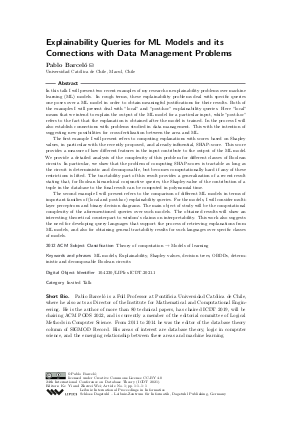Explainability Queries for ML Models and its Connections with Data Management Problems (Invited Talk)
Author Pablo Barceló
-
Part of:
Volume:
24th International Conference on Database Theory (ICDT 2021)
Part of: Series: Leibniz International Proceedings in Informatics (LIPIcs)
Part of: Conference: International Conference on Database Theory (ICDT) - License:
 Creative Commons Attribution 4.0 International license
Creative Commons Attribution 4.0 International license
- Publication Date: 2021-03-11
File

PDF
LIPIcs.ICDT.2021.1.pdf
- Filesize: 291 kB
- 1 pages
Document Identifiers
Subject Classification
ACM Subject Classification
- Theory of computation → Models of learning
Keywords
- ML models
- Explainability
- Shapley values
- decision trees
- OBDDs
- deterministic and decomposable Boolean circuits
Metrics
- Access Statistics
-
Total Accesses (updated on a weekly basis)
0PDF Downloads0Metadata Views
Abstract
In this talk I will present two recent examples of my research on explainability problems over machine learning (ML) models. In rough terms, these explainability problems deal with specific queries one poses over a ML model in order to obtain meaningful justifications for their results. Both of the examples I will present deal with “local” and “post-hoc” explainability queries. Here “local” means that we intend to explain the output of the ML model for a particular input, while “post-hoc” refers to the fact that the explanation is obtained after the model is trained. In the process I will also establish connections with problems studied in data management. This with the intention of suggesting new possibilities for cross-fertilization between the area and ML. The first example I will present refers to computing explanations with scores based on Shapley values, in particular with the recently proposed, and already influential, SHAP-score. This score provides a measure of how different features in the input contribute to the output of the ML model. We provide a detailed analysis of the complexity of this problem for different classes of Boolean circuits. In particular, we show that the problem of computing SHAP-scores is tractable as long as the circuit is deterministic and decomposable, but becomes computationally hard if any of these restrictions is lifted. The tractability part of this result provides a generalization of a recent result stating that, for Boolean hierarchical conjunctive queries, the Shapley-value of the contribution of a tuple in the database to the final result can be computed in polynomial time. The second example I will present refers to the comparison of different ML models in terms of important families of (local and post-hoc) explainability queries. For the models, I will consider multi-layer perceptrons and binary decision diagrams. The main object of study will be the computational complexity of the aforementioned queries over such models. The obtained results will show an interesting theoretical counterpart to wisdom’s claims on interpretability. This work also suggests the need for developing query languages that support the process of retrieving explanations from ML models, and also for obtaining general tractability results for such languages over specific classes of models.
Cite As Get BibTex
Pablo Barceló. Explainability Queries for ML Models and its Connections with Data Management Problems (Invited Talk). In 24th International Conference on Database Theory (ICDT 2021). Leibniz International Proceedings in Informatics (LIPIcs), Volume 186, p. 1:1, Schloss Dagstuhl – Leibniz-Zentrum für Informatik (2021)
https://doi.org/10.4230/LIPIcs.ICDT.2021.1
BibTex
@InProceedings{barcelo:LIPIcs.ICDT.2021.1,
author = {Barcel\'{o}, Pablo},
title = {{Explainability Queries for ML Models and its Connections with Data Management Problems}},
booktitle = {24th International Conference on Database Theory (ICDT 2021)},
pages = {1:1--1:1},
series = {Leibniz International Proceedings in Informatics (LIPIcs)},
ISBN = {978-3-95977-179-5},
ISSN = {1868-8969},
year = {2021},
volume = {186},
editor = {Yi, Ke and Wei, Zhewei},
publisher = {Schloss Dagstuhl -- Leibniz-Zentrum f{\"u}r Informatik},
address = {Dagstuhl, Germany},
URL = {https://drops.dagstuhl.de/entities/document/10.4230/LIPIcs.ICDT.2021.1},
URN = {urn:nbn:de:0030-drops-137091},
doi = {10.4230/LIPIcs.ICDT.2021.1},
annote = {Keywords: ML models, Explainability, Shapley values, decision trees, OBDDs, deterministic and decomposable Boolean circuits}
}
